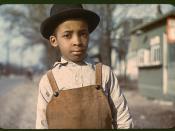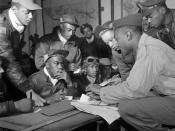Africans in America (1931-1955)A movement of great importance and deep meaning came about during a time not so long past. The 1930's-50's brought a movement of integrity and of the idea that though we are all different people, we belong to one country.
A major turning point in standing against oppression came in the case of Brown vs. Board. Brown vs. Board of Education is commonly mistaken as a single case, when it was really a combination of five cases; all dealing with segregation in schools.
In Kansas was the Brown vs. Board case. It argued over the eighteen schools for whites and the only four available for blacks. The decision was unanimous that segregation was wrong. Delaware's case was Belton vs. Gebhart where kids were forced to ride a bus for an hour and in some cases given no transportation at all to a one-room shack. While the plaintiffs won, not all Delaware schools were affected by the decision.
South Carolinas Briggs vs. Elliot fought for equal facilities. The order for change resulted in no change nonetheless. In Virginia Davis vs. County School Board of Prince Edward County resulted in a ruling for better building conditions. D.C.'s Bolling vs. Sharpe decision was that "segregation in D.C. is a denial of the due process of law guaranteed by the Fifth Amendment."While the Brown vs. Board of Education cases collectively resulted in a change for African Americans education, it did not solve segregation immediately, though it did set the stage for the later civil rights movement.
The civil rights movement is often associated with the bus boycotts and Rosa Parks in the mid 1950's to 1960's. However, the movement started with the Depression in the 1930's. The unemployment rates of blacks during this time sparked writers, like Langston Hughes, to speak...


